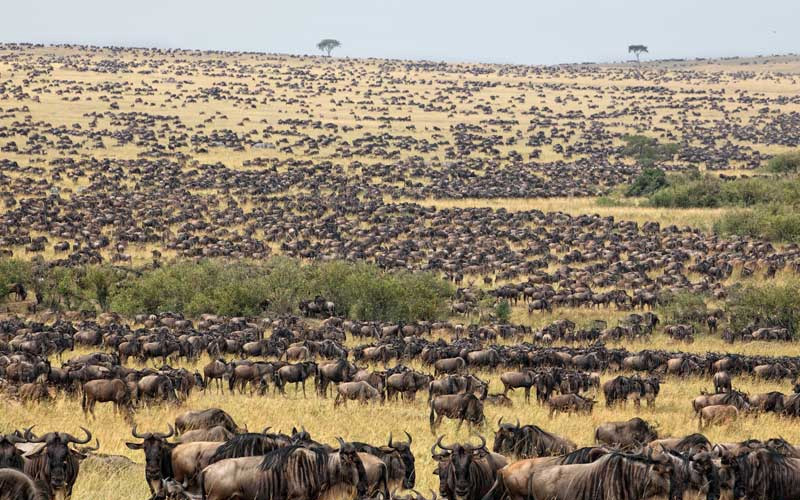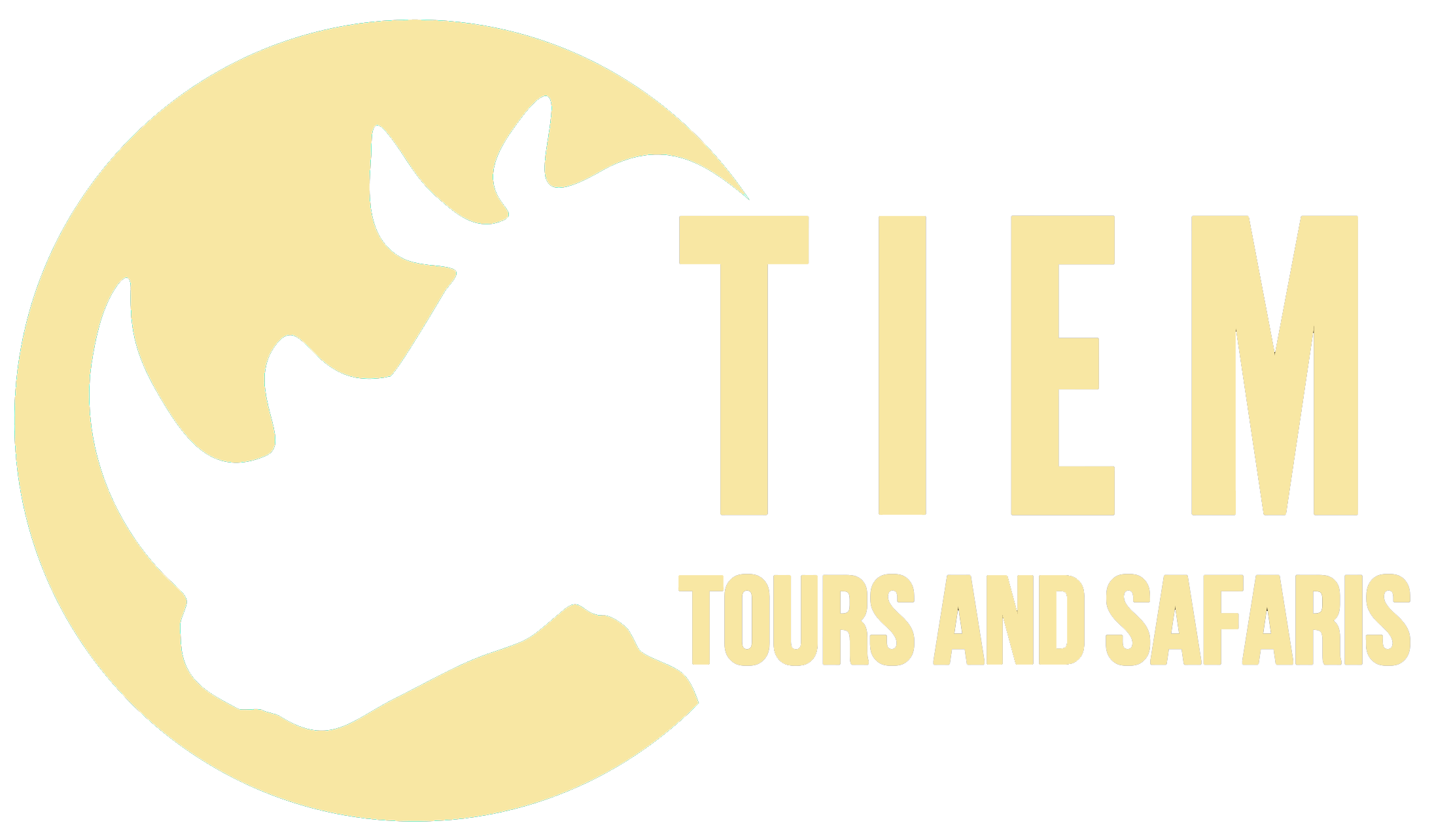Overview
Great Wildebeest Migration Safari Package
This adventure of great wildebeest migration will take you to the north of Serengeti, when the drought comes in May, the herd moves north, towards the Masai Mara in Kenya, chomping down the high green grass, quickly followed by the gazelles and zebras. The migration is not without risk: crossing rivers means facing about 3,000 crocodiles, patiently waiting for a kill. Not to mention the famous Serengeti lion population: by far the largest in Africa. Despite the abundance of hoofed meat in this area, life is not easy for these big cats in this unforgiving landscape. But seeing a group of lions collaborating to hunt down a wildebeest is an unforgettable sight.

Itinerary
Day 1: Arrival In Arusha
On your arrival at Kilimanjaro International airport, you’ll be met by our representative and then transfer to Arusha overnight. Spend the day at leisure
Day 2: Arusha – Lake Manyara National ParkArusha
You’ll depart from Arusha after breakfast and drive to Lake Manyara National Park. The journey takes approximately two hours, but we’ll pass through the market town of Mto Wa Mbu along the way. This agricultural and fresh produce market is a melting pot of local cultures and a souvenir hunter’s paradise.
After a brief stop at the village market, you’ll enter Lake Manyara National Park. The park is truly a photographer’s playground and offers some of the best game viewings in the world. You can expect to see many of Africa’s most well-known animals, with the tree-climbing lions a particular treat. These proud predators lounge in acacia trees practically begging to be photographed.
Bird-watchers will find Lake Manyara an absolute delight, with a huge variety of birds on display in the park. Even the novice can expect to be amazed by large flamingo flocks, circling birds of prey, and the brightly colored lilac-breasted roller. Later drive to karatu Region to the hotel/lodge for dinner and overnight
Day 3: Karutu To Serengeti National Park (SERONERA)
We’ll take an early breakfast, as we’ve got a big day of exploration and adventure ahead of us!
We’ll begin the day with the scenic drive towards the Serengeti. Along the way, we’ll pass through the mist-shrouded rainforests of the Ngorongoro Conservation Area where you might be lucky enough to glimpse cape buffalo, baboons, or even elephants and leopards in the dense undergrowth.
It’s a nearly four-hour drive to the Serengeti park gates, but you can choose to break up the drive with one or both of the below optional activities on request with an extra payment.
Olduvai Gorge Museum: Sometimes known as the Cradle of Mankind, the Olduvai Gorge Museum commemorates some of the oldest evidence of human habitation ever found. Here you can see some of the oldest fossil evidence in the world of human habitation, visit the Olduvai Gorge Museum to learn more about the human journey, and take in the stunning views of this stark gorge country.
Maasai boma visit: Pay a visit to one of the famous Maasai bomas, where you’ll have the opportunity to witness (and participate in) traditional Maasai dance, tour an authentic Maasai village, and even do a little souvenir shopping at the local market.
After a delicious lunch at the Serengeti National Park picnic area, it’s time to explore the Serengeti itself. Witness Africa’s iconic savannah landscape and be amazed by the sheer number of animals that roam these grassy plains.
Dinner and overnight in the heart of the Serengeti National Park at the hotel/tented camp
Day 4: Serengeti National Park (KOGATENDE)
After breakfast, we will drive across the plains of Togoro and through the Mbuzi Mawe kopjes (small hills) as we make our way into the park’s northern reaches.
Along the way, you’ll have the opportunity to see the Serengeti’s diverse scenery as you pass through wooded hills, tumbledown kopjes, and the wide open savannah. Your drive will show you everything from the diminutive dik-dik to towering elephants and giraffes.
Upon arriving in the Kogatende region, you’ll go out in search of both the Wildebeest Migration and the famous Big Five. Late evening drive to the tented camp for dinner and overnight
Day 5: Serengeti National Park(KOGATENDE)
After breakfast, we’ll start our game drive around the Kogatende area, searching around the kopjes looking for carnivores and the large migration groups that will be preparing to cross the Mara River into Kenya.
Home to large numbers of hippos and Nile crocodiles, the Mara River is the last major obstacle standing between the Wildebeest Migration and the relative safety of the Masai Mara. If you’re patient and a little lucky, you may even get to witness the death-defying crossing itself where wildebeest and zebras brave the river’s currents and crocodiles in an attempt to reach safety on the opposite bank.
Day 6: Serengeti – Ngorongoro Conservation Area
After breakfast, we get right on the road back towards the Ngorongoro Crater National Park.
Our drive takes us back through the Serengeti via a different route, offering plenty of opportunities to spot the animals that eluded you on day two. As far as the eye can see, you’ll spot thousands upon thousands of animals in herds; wildebeests and zebras migrating together, tall and graceful giraffes, jumping antelopes and gazelles, the powerful African elephant and the most respected group of animals: the predators.
You will have the chance to spot lean cheetahs and shy leopards, foraging hyenas, and last but not least, the king himself; the lion.
Dinner and overnight at the Lodge/ tented camp on the rim of the Ngorongoro Crater or in nearby Karatu Town.
Day 7: Ngorongoro Conservation Area – Arusha
After breakfast, you’ll depart for Ngorongoro Crater; considered by some to be the Eighth Wonder of the World. When you get your first glimpse of this vast, verdant caldera from the panoramic viewpoint, you’ll soon understand why it has earned such a lofty reputation.
Home to over 120 species of mammal including the fabled Big Five, the Ngorongoro Conservation Area is one of the most sought-after safari destinations in the world. It’s a particularly good place to see the endangered black rhinoceros enjoying a lonely meal out on the grass plains, as well as a place to see large numbers of hippopotamus enjoying the cool water.
From the comfort of your open-top vehicle, you’ll be able to observe and photograph some of Africa’s most recognizable faces. The crater is home to a large number of predators including lions, leopards, cheetahs, jackals, and hyenas, as well as a large population of wildebeest, zebras, antelope, Cape buffalo, and more. It is truly one of Africa’s premier safari destinations.
After the thrills and excitement of the day, you will have a picnic lunch by the park’s famous hippo pool before returning to Arusha overnight.
INCLUDED
- Full board accommodation whilst on safari in the Lodge /tents campsite.
- All park fees (entry fees, transit, and crater fees)
- A highly – credentialed private English Speaking Driver /Guide during your journey.
- Mineral water on a board safari vehicle
- Transportation in a 4×4 safari vehicle (Private) and all airport transfers
- Government taxes
NOT INCLUDED
- Tanzania Visa: $50 per person on arrival, USA and CANADA passport holders USD.100
- International flight and domestic flight
- Optional Tours (balloon rides USD. 500 per person etc.)
- COVID 19 Certificate test fees – But we can help you to get it on time.
- Meals and transfers other than those specified in the sample itinerary.
- Items of a personal nature such as laundry, drinks, and other expenses at hotels, gratuities to safari guide, waiters and waitress at the hotel, etc.
